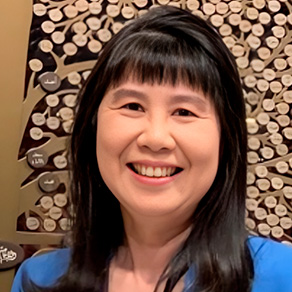
Linda B. Smith
[intermediate] Toddlers and Machines: Insights into Efficient Learning
Summary
Human toddlers are highly efficient learners. By their second birthday, with just under 3000 waking hours of learning from the world, they learn on average 9 new words a day, and are one one-shot learners of visual categories. They can immediately generalize from one kind of event to the expected components of a similar one (from how one gets a hamburger at MacDonald’s works to how one orders a pizza in the pizza shop). Toddlers are not smarter than contemporary AI; they know a lot less. But contemporary AI requires orders of magnitudes (lifetimes) more data to learn what a toddler can in days, hours, or one experience. When faced with such evidence of greater efficiency, theorists often propose that the young human learner arrives with “priors” or “inductive biases” or “innate ideas” that guide their interpretation of the messy sparse training data. What are these? Are they useable by machine learning? The two lectures will present evidence on the biases in the world (the physics of space and time) in the behavior of toddlers that creates selective and potentially optimal data sets for learning. Are there useable principles for increasing the efficiency of AI?
Syllabus
- The data matters
- Low, mid-level, and semantic statistics of the input
- A curriculum
- Zipf and small world networks
- Efficient word learning
- Space, time, and memory for events
References
Lecture 1:
Braddick, O., & Atkinson, J. (2011). Development of human visual function. Vision Research, 51(13), 1588-1609.
Pinto, Nicolas, Cox, David D., & DiCarlo, James J.. Why is real-world visual object recognition hard. PLoS Computational Biology, 4.1 (2008): e27.
Li, Y., & Benitez, V. L. (2025). Concurrences across time and sensorimotor capacities promote infant learning. Child Development Perspectives, 19(2), 99-107.
Elder, J. H., Peterson, M. A., & Walther, D. B. (2024). Perceptual organization in computer and biological vision. Frontiers in Computer Science, 6, 1419831.
Anderson, E. M., Candy, T. R., Gold, J. M., & Smith, L. B. (2024). An edge-simplicity bias in the visual input to young infants. Science Advances, 10(19), eadj8571.
Pereira, A. F., James, K. H., Jones, S. S., & Smith, L. B. (2010). Early biases and developmental changes in self-generated object views. Journal of Vision, 10(11), 22-22.
Lecture 2:
Zipf, G. K. (1949). Human behavior and the principle of least effort: An introduction to human ecology. Ravenio Books.
Murre, J. M., & Dros, J. (2015). Replication and analysis of Ebbinghaus’ forgetting curve. PloS One, 10(7), e0120644.
Sheybani, S., Hansaria, H., Wood, J., Smith, L., & Tiganj, Z. (2023). Curriculum learning with infant egocentric videos. Advances in Neural Information Processing Systems, 36, 54199-54212.
Wood, J. N. (2024). Artificial intelligence tackles the nature–nurture debate. Nature Machine Intelligence, 6(4), 381-382.
Clerkin, E. M., & Smith, L. B. (2022). Real-world statistics at two timescales and a mechanism for infant learning of object names. Proceedings of the National Academy of Sciences, 119(18), e2123239119.
Clerkin, E. M., Hart, E., Rehg, J. M., Yu, C., & Smith, L. B. (2017). Real-world visual statistics and infants’ first-learned object names. Philosophical Transactions of the Royal Society B: Biological Sciences, 372(1711), 20160055.
Karmazyn-Raz, H., & Smith, L. B. (2023). Discourse with few words: Coherence statistics, parent-infant actions on objects, and object names. Language Acquisition, 30(3-4), 211-229.
Karmazyn-Raz, H., & Smith, L. B. (2023). Sampling statistics are like story creation: a network analysis of parent–toddler exploratory play. Philosophical Transactions of the Royal Society B, 378(1870), 20210358.
Pre-requisites
Only prerequisite is open mind.
Short bio
Linda B. Smith, Distinguished Professor at Indiana University Bloomington, is an internationally recognized leader in cognitive science and cognitive development. Taking a complex systems perspective, she seeks to understand the interdependencies among perceptual, motor, and cognitive developments during the first three years of post-natal life. Using wearable sensors, including head-mounted cameras, she studies how the young learner’s own behavior creates the statistical structure of the learning environments with a current focus on developmentally changing visual statistics at the scale of everyday life and their role in motor, perceptual, and language development. The work extended through collaborations has led to new insights in artificial intelligence. Her work has been continuously funded by the National Science Foundation and/or the National Institutes of Health since 1978. She won the David E. Rumelhart Prize for Theoretical Contributions to Cognitive Science, the American Psychological Association Award for Distinguished Scientific Contributions, the William James Fellow Award from the American Psychological Society, the Norman Anderson Lifetime Achievement Award, and the Koffka Medal. She is an elected member of both the National Academy of Sciences and the American Academy of Arts and Science. Although a developmental scientist, she has given keynote talks to the AI community, including Amazon Machine Learning, the Posner Lecture at NeurIPS 2023, and will give a keynote at ICCV in Hawaii in October 2025.













